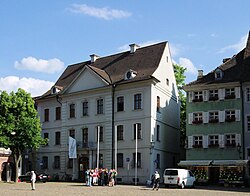Final Project: Wentzingerhaus (Museum of Municipal History)
 Wentzingerhaus in Freiburg | |
| Established | 1994 [1] |
|---|---|
| Location | Freiburg im Breisgau, Germany |
| Type | History museum |
| Director | Carola Freund M.A. |
| Owner | City of Freiburg |
| Website | Freiburg Museums: Museum for City History |
The Museum of Municipal History (German: Museum für Stadtgeschichte ) of Freiburg’s municipal museums in the late baroque house “Zum Schönen Eck” (Wentzingerhaus) shows the history of the city of Freiburg im Breisgau from its beginnings around 1100 to the baroque period. Further historical topics up to the present are covered in temporary exhibitions. The museum was opened in spring 1994. Previously was it comprehensively and in accordance with accepted preservation practice restored by the Adelhausen Foundation Freiburg, who had acquired the building from the city in 1988. The Museum of Municipal History is a department of the nearby Augustiner Museum.
History and Building
edit
As one of the few preserved artist residences in Germany the Wentzingerhaus itself is part of the presentation of the city’s history. The building was built after 1760 by artist and philanthropist Johann Christian Wentzinger (1790-1797) as a studio and residence for himself . The middle section of the three-story façade shows an elaborately framed columned portal with a balcony on the first floor. Its railing is decorated with a small self-portrait of the landlord in bust form.
The layout of Wentzinger’s apartment and the remnants of decorations are preserved in the salon and living room in the piano nobile. On the ground floor were the kitchen and utility rooms, on the top floor presumably the artist’s studio space. The large vaulted cellars are baroque.
After the completion of the third construction phase at the Augustiner museum in 2024, the relocation of the city history exhibits in the local western wing is planned, where the city and cathedral history will be newly presented. The future use of the Wentzingerhaus after the departure of the city history is still open.
Collection
editIn the museum can be found, among other things, exhibitions about the time of the House of Zähringen, who admittedly died out in 1218 with Berthold V, Duke of Zähringen, but as founders of the city are at the beginning of a lasting Zähringen tradition, which continues to this day. There are also documents and exhibitions about the changing of the city rights in Freiburg, beginning with the House of Urach, which called themselves the Counts of Freiburg as heirs of House of Zähringen, about the strengthening of the guilds, the transition to the House of Habsburg until the fall of the Grand Duchy of Baden in the Napoleonic era.
Another theme of the museum is the Freiburg Minster; through a detailed model of the cathedral in 1:50 scale the building technique of the Gothic period is explained. Historical documents on the separate construction phases, equipment and Wentzinger’s model for the funerary monument of General von Rodt are on display in the minster.
Also examined is the era of the Thirty Years' War and its aftermath, especially the fortification by Sébastien de Vauban. A central object is the baroque “Pergamentplan”, a drawn bird’s eye view of the fortress, which also shows the inner-city in considerable detail. Another special feature are the rare glass hand grenades from around 1740, which emerged on an archeological dig in the fortress area in 2007.
Another room is dedicated to trade, coinage, mining, crafts and trades. Monastic life is primarily represented by Adelhauser Abbey, the most important women’s monastery in Freiburg. Important archaeological exhibits are from the Augustinian Monastery of Freiburg. The history of Albert Ludwig University of Freiburg and the Freiburg hospitals are in the vicinity.
A city model in the vaulted cellar can provide visitors a preparation for a city tour. It shows Freiburg with its medieval walls and gates around 1600. City scapes and plans complement it. For the anniversary exhibition “freiburg. archaeology” 2019/2020, a medieval cesspit discovered in the run-up to the renovation in 1988 was partially uncovered by archaeologists from the state office for monument protection and left exposed as an excavation site. An escape passage leading to an exit on the Minster Square, which was created before the Second World War in the course of air raid protection brings to mind recent history.
A special feature until 2009 was the Steinway- Welte reproducing grand piano, which is now again displayed in the Augustiner museum. A reproducing piano is a type of player piano.
Literature
edit- Peter Kalchthaler: Wentzingerhaus, Museum für Stadtgeschichte: ein Führer durch die stadtgeschichtliche Sammlung des Augustinermuseums Freiburg. (Wentzingerhaus, Museum of Municipal History: A Guide through the Historical City Collection of the Augustiner Museum of Freiburg) Promo-Verlag, Freiburg i. Br. 1996, ISBN 3-923288-19-0.
References
edit- ^ "Stadtgeschichten im barocken Künstlerhaus". Städtischen Museen Freiburg. Retrieved 28 June 2023.
External Links
editCommons: Category: Wentzingerhaus Freiburg - Collection of images, videos, and audio files